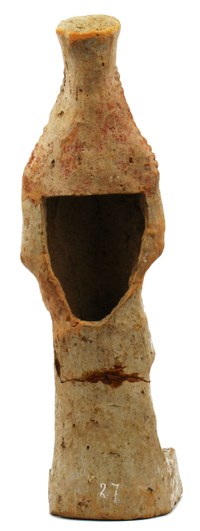Women's figurines with high polos
Particularly widespread among polos-wearing women is a group of peplos figurines[1] whose polos are crowned by a serrated attachment plate[2]. The same headdress occasionally appears on female figures in chiton and cloak[3]. Rarely do they wear a polos without the three-pronged decorative plate[4]. This particularly small group is followed by the statuette Giessen T I-35.
|
Women's figurines with high polos, Inv. T I-35 Front side from the mould. Back not finished, smoothed, large kilning hole. Provenance: Acquired by Bruno Sauer, from the Margaritis Collection State of preservation: Composed of two fragments. Small bumps at the base, otherwise intact. Dimensions: H: 31,2 cm; W: 8,8 cm; D: 8,6 cm References: M. Recke (Hrsg.), Antike Kunst aus der Sammlung der Justus-Liebig-Universität (Gießen 2010) 22 f. 27 no. 45 a. |
Description: A woman in a long sleeve chiton and coat stands on a high square plinth. The right leg is slightly bent at the knee. The straight upright body leans slightly backwards. The feet are placed at a short distance from each other and almost parallel. The fabric of the undergarment lies without folds on the right leg, while steep folds fall down over the left.
The cloak, apparently made of heavy, thick fabric, is draped over the left shoulder, completely envelops the bent left arm and wraps around the hips as a wide web in dense diagonal folds. Tension folds run from the bent right elbow to the waist area. The right hand lies in front of the chest with the fingers pointing upwards.
The high polos[5], which widens slightly towards the top, is set low on the forehead. The long, evenly waved strands of hair fall so far over the shoulders that the face and neck are framed as if by a triangle.
The face shows the shape of a high rectangle, with smooth cheeks, a large nose and eyes set wide apart. The brows are vividly highlighted. A puncture in the right eye possibly marks the pupil. The mouth is cut horizontally, the lips are closed.
Commentary: It is probably a depiction of an adorantess whose gift, a blossom or small fruit, held between her fingers, was probably once indicated in painting. A parallel in Dresden[6], which is largely similar to the Giessen example, probably depends on the same matrix. A figure in Leiden[7], which is reproduced in the reverse stance motif, appears considerably smaller, also broader and more two-dimensional. The folds of the robe are treated schematically and appear more graphic than sculptural. Parting forehead hair peeks out from under the less high polos, the face is shorter and more rounded, the mouth is more delicate and the eyes are smaller. The statuettes in Copenhagen and Karlsruhe[8] wear poloi with decorative plates. Lush forehead hair spills out from under the headgear. The faces are oval, the proportions more delicate than those of the representatives in Giessen and Dresden. In the latter, arched folds of the mantle guide the gaze around the figures, creating a rounded sculptural impression. With their angular heads and heavy lower faces, they point to the period of the Severe Style[9]. This dating approach is supported by the stance motif, as the different load on the legs does not yet have an effect on the body axis in the sense of a ponderation.
Determination: Second quarter of the 5th century BC, Boeotia.
[1] H. Holzhausen, Böotische Terrakotten des 5. und 4. Jahrhunderts vor Christus (Bonn 1972) 17 f; E. Paul, Antike Welt in Ton (Leipzig 1959) 65 fig. 24 pl. 10; P. C. Bol – E. Kotera, Bildwerke aus Terrakotta Liebieghaus Frankfurt am Main (Melsungen 1986) 81 f. fig. 43.
[2] F. W. Hamdorf, Dir figürlichen Terrakotten der Staatlichen Antikensammlungen München I (Lindenberg 2014) 190 f. fig. D 109-111; R. A. Higgins, Cat. of the Terracottas in the Department of Greek and Roman Antiquities British Museum (London 1954) 218 figs. 815. 816 pl. 111; M. Raumschüssel, Staatliche Kunstsammlungen (Dresden 1979) 45 fig. 10; W. Schürmann, Kat. der antiken Terrakotten im Badischen Landesmuseum Karlsruhe (Göteborg 1989) 38 f. fig. 81 pl. 17; Th. Stefanidou-Tiveriou, Pilina Eidolia (Thessaloniki 1982) 34-36 nos. 27. 28 figs. 30-33; C. E. Vafopoulou-Richardson, Greek Terracottas Ashmolean Museum (Oxford 1991) 23 fig. 24; A. Köster, Die griechischen Terrakotten (Berlin 1926) 46 pl. 16; S. Mollard-Besques, Cat. rais. des figurines et reliefs en terre cuite grecs étrusques et romains (Paris 1954) 91 C 49 pl. 64. Chiton mit langem Kolpos ohne Mantel, K. Demakopoulou – D. Konsola, Archäologisches Museum Theben (Athen 1981) 64 f. fig. 21; P. N. Ure, Aryballoi & Figurines (Camridge 1934) 73 no. 136. 1 pl. 19.
[3] N. Breitenstein, Cat. of Terracottas (Kopenhagen 1941) 30 fig. 278 pl. 31; A. Laumonier, Cat. des terres cuites du Musée de Madrid (1921) 14 no. 26 pl. 8; Schürmann ibid. 36 no. 70 pl. 15.
[4] W. Müller, Erwerbungen der Antikensammlungen in Deutschland. Dresden, AA 1925, 148 fig. 43; P. G. Leyenaar-Plaisier, Les terres cuites grecques et romaines (Leiden 1979) 30 fig. 46 pl. 8.
[5] Breitenstein ibid. no. 280 pl. 31; U. Liepmann, Griechische Terrakotten, Bronzen, Skulpturen (Hannover 1975) 64 no. T 49; Ch. Papadopoulou-Kanellopoulou, Silloge Károlou Políte (Athen 1989) 120 no. 70 fig. 126; S. Besques, Figurines et reliefs grecs en terre cuite (Paris 1994, 24. 43 fig. 10.
[6] Müller ibid. 148 fig. 43.
[7] Leyenaar-Plaisier ibid. 30 fig. 46 pl. 8.
[8] Breitenstein ibid. 30 fig. 278 pl. 31; Schürmann ibid. 36 no. 70 pl. 15.
[9] V. H. Poulsen, Der Strenge Stil (Kopenhagen 1937) 9 fig. 1. 13 Abb. 6. 73 figs. 42. 43.




